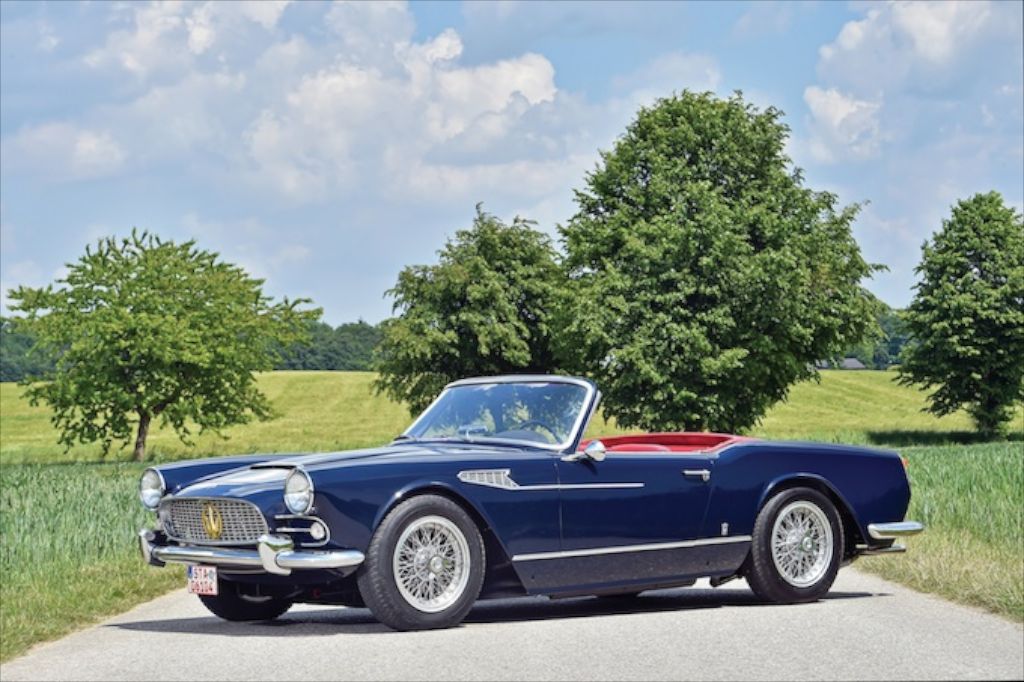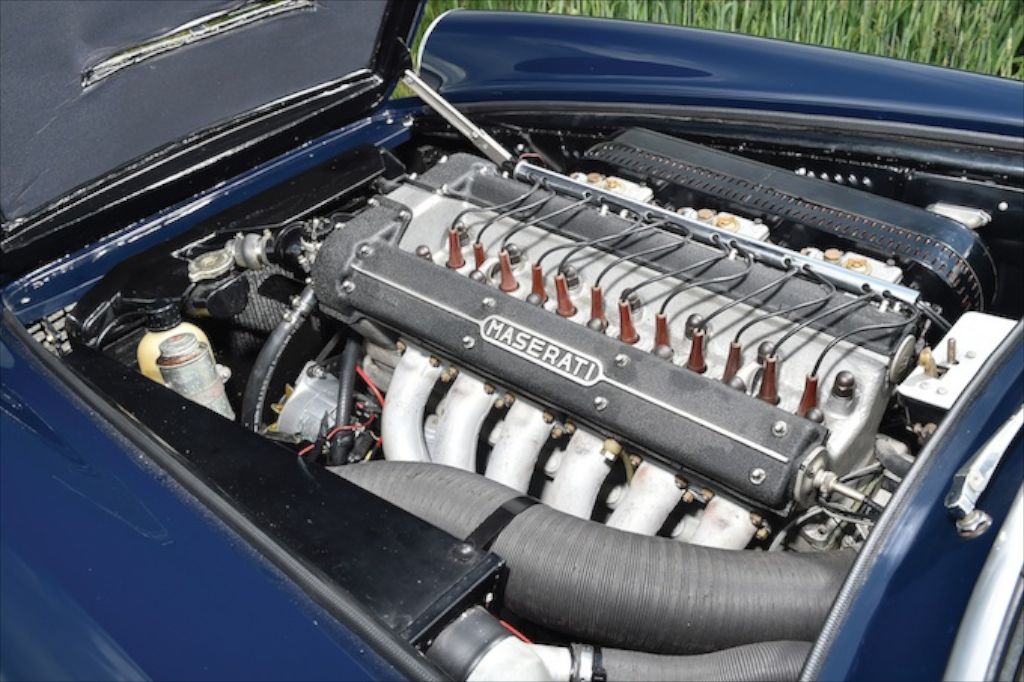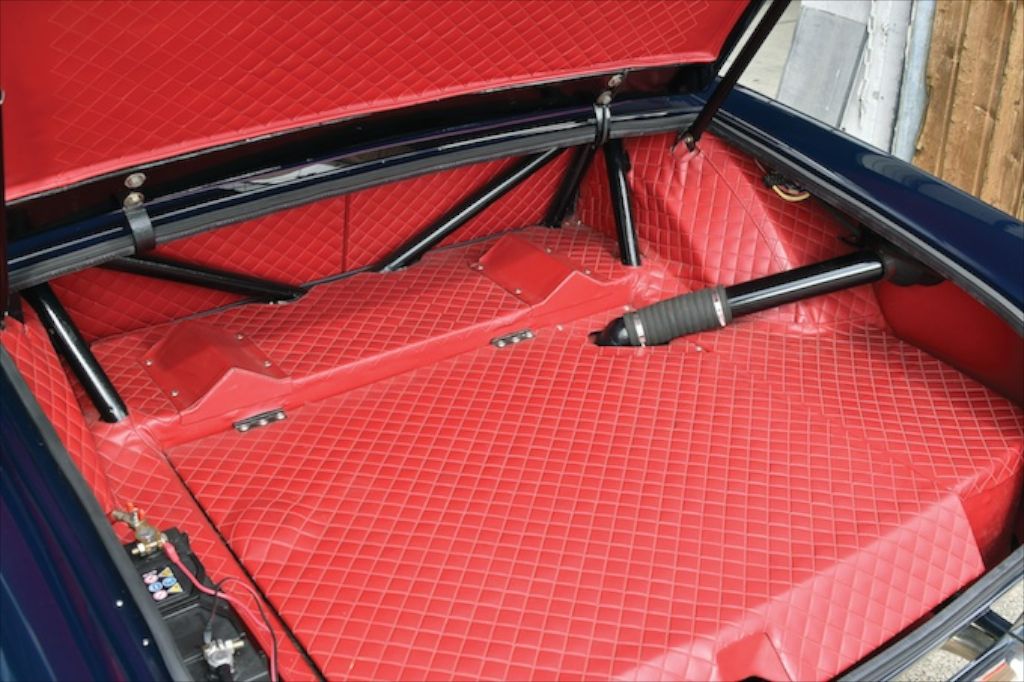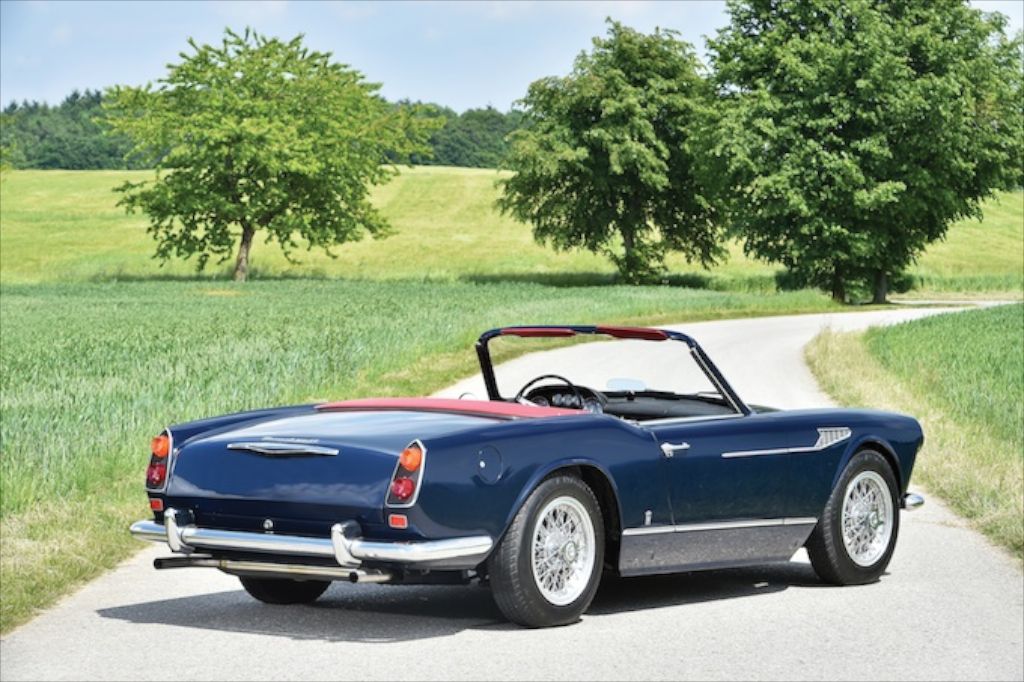Published in Monterey Car Week (Maserati 3500 GT)
Editor’s Note: Thanks to RM Auctions for permitting Monterey Car Week to publish these sweet photos and the articulate article on a super nice Maserati 3500 GT.
Lot 138
1959 Maserati 3500 GT Spyder Prototype by Vignale
Sold for $1,072,500
Chassis no. AM101.678
Photo Credit: Tim Scott ©2014 Courtesy of RM Auctions
Maserati 3500 GT
220 bhp, 3,485 cc DOHC inline six-cylinder engine with triple Weber 42 DCOE carburetors, four-speed manual gearbox, independent front suspension with coil springs, live rear axle with semi-elliptic leaf springs and tubular shock absorbers, and four-wheel drum brakes. Wheelbase: 100 in.
- One of a believed three Vignale-bodied prototypes; arguably the most elaborate
- Delivered new to renowned sportsman Lindsey Hopkins
- Reported to have a matching-numbers drivetrain
- Subject of a nut-and-bolt restoration
- Documented by original Maserati factory delivery paperwork
When it was introduced in March 1957 at the Geneva Motor Show, the Maserati 3500 GT Coupe was the marque’s big hope for the future. Maserati was primarily known through the 1950s for their competition successes and fielding some of the day’s most potent engine and chassis combinations, but it had spread itself thin, to the point of near insolvency, by the end of the decade, with entries in three different sports car classes as well as Formula One racing. A fundamental lack of financing badly hampered each of these pursuits, and despite the immense potential of racing sports cars, like the four-cylinder 250S and the V-8-equipped 450S, it was the six-cylinder 300S that became the marque’s most consistent competition performer, consequently absorbing most of the engineering team’s attention.
With the cancellation of its major racing programs just over the horizon, Maserati needed a production car that could catapult the company to solvency, and it found its proven straight-six engine the most suitable for serial production. Although prior models like the A6GCS/53 and A6G2000 GT were beloved by the Modena faithful, their hand-built construction and low production volume undermined any potential for profit. The 3500 GT addressed these concerns with an extension of the competition inline six-cylinder motor, which was now reworked to displace 3.5 liters and was tuned with a modified camshaft, a design based on the 350S. With elegant coupe coachwork by Touring, the 3500 GT went on to be the company’s biggest commercial success to date, eventually producing an impressive quantity of almost 2,000 examples over eight years.
THE VIGNALE SPYDERS
From the inception of the 3500 GT, Maserati intended to create a spyder version, but as was often the case with Italy’s boutique automakers of the time, considerations of capacity and choice of carrozzeriere were always challenging issues. During 1957 and 1958, Frua and Touring individually bodied at least three of the early 3500 GT Spyders, but Maserati was clearly not convinced by any of these designs. By 1959, the marque selected for production was a variation on the three that had been posed by Vignale, which officially debuted at the Turin Motor Show later that year. The Vignale Spyders were constructed on a slightly shorter wheelbase than the coupes, and they soon became the premium open Italian sports cars of their day, rivaling Ferrari’s 250 GT Cabriolets as the most elegant and exclusive sporting convertibles on the road. Just 242 examples of the luxurious Vignale Spyder were eventually produced, adding a degree of rarity to their distinctive style.
THE PROTOTYPE, CHASSIS NUMBER AM101.678
Chassis 101.678 is approximately the tenth open 3500 GT built, and it is one of as few as three prototypes built by Vignale as they searched for the perfect combination of styling cues. Physically, this car differs from the forthcoming production version in its side trim, principally with the angular semi-sweep-spear design that starts towards the front fender’s crest, carries through the door, and then commences with a mesh outlet similar to the front grille, which itself was uniquely extravagant, with its hint of Dual Ghia side grilles. This exquisite brightwork is among many features that serve to distinguish this prototype from the short center-placed vents later seen on the production Vignale Spyders.
According to a copy of an original factory delivery note, this car was dispatched on February 15, 1960, to its first owner of record, Lindsey Hopkins. This was almost certainly the great investor and real estate magnate from North Carolina, who was known to be a respected sportsman in the post-war years. In addition to heavily investing in Bahamian real estate, which eventually helped fuel the Bahama Speed Week races, Mr. Hopkins sponsored his own race teams, which alternately appeared in venues as varied as the 12 Hours of Sebring and the Indianapolis 500. He also later partnered with racing team principal John Mecom to become the first owners of the New Orleans Saints NFL expansion franchise. As detailed by the original Maserati document, this Spyder was delivered in the care of Waco Motors in Miami, Florida (a city where Mr. Hopkins managed numerous business interests), prompting speculation that the car was ordered directly from the factory by the new owner.
By the 1990s, chassis 101.678 had come into the care of Texas resident William Strange, who reportedly had begun a restoration but left the car in a disassembled state for a number of years. Following a bankruptcy proceeding, the car passed through dealer Garry Roberts, who sold it in 1996 to Kenneth Glynn, of Melbourne, Australia. Mr. Glynn’s partner in the deal, marque expert and racing participant Mario Lombardi, had been searching for good barnyard-find Maserati examples to restore, and he made a deal to acquire this car and two coupes, a 3500 GT and a 3500 GTi, under Mr. Strange’s care.
Mr. Lombardi was delighted to discover such a unique prototype example of the Vignale Spyder, and he treated the car to a full nut-and-bolt refurbishment. In addition to a complete mechanical freshening, the interior was reupholstered with red Connolly leather-covered paneling and seats with grey piping and was trimmed with complementary blue carpeting, while the exterior was refinished in a deep coat of dark blue paint. A wrinkle finish was applied to the dashboard and taillight housings, and the trunk was lined with proper diamond-quilted leather, which was to become a Maserati signature.
This sensationally restored 3500 GT Vignale Spyder Prototype was acquired more recently by the consignor, and to ensure that the car remains in good running condition and maintains its concours-quality presentation, it has been freshened in preparation for its current offering. It is a supremely sporty and elegant example, with its unique shortened-chassis proportions and muscular coachwork. It could easily be the crowning addition to any collection of one-off designs or early 1960s sports convertibles or an eye-catching and satisfying entrant for concours or vintage touring events.














